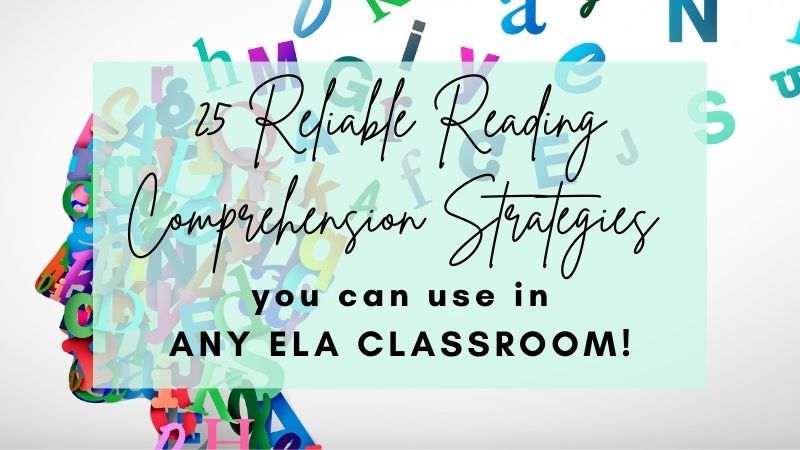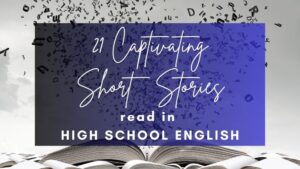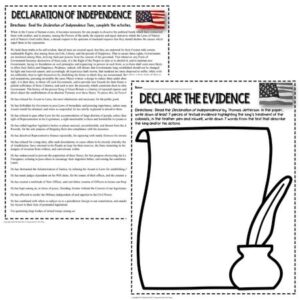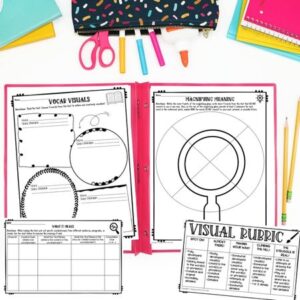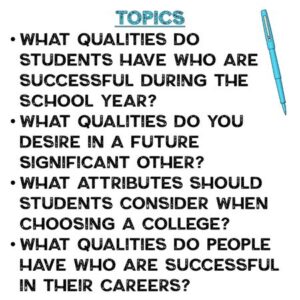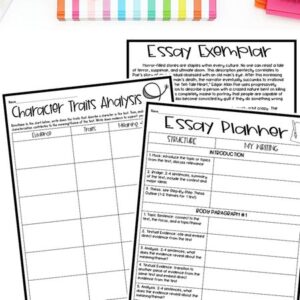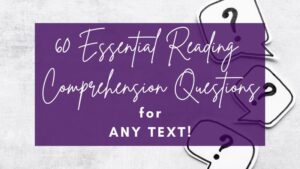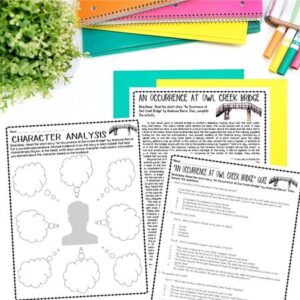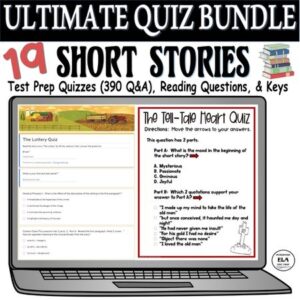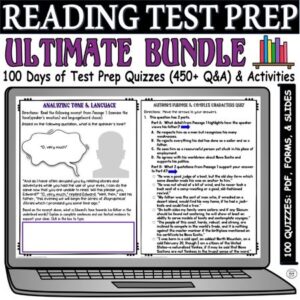Reading comprehension strategies are all the rage right now, and I get why. Overall, students are simply not progressing like they should be considering we spend an average of $15,000/per student each year on schooling (U.S. Census Bureau).
Unfortunately, that money is rarely spent on actual resources that include reading comprehension strategies for the classroom. When I first started teaching, I had zero reading curriculum and only about 15-20 literature textbooks in classes of over 30 students. Many students had to share, and NONE could take home any books.
On top of that, so many gurus over my 17 years of teaching came into the schools touting some sort of miracle program to bring up ALL students’ reading levels.
After so many years, I have yet to see a reading comprehension strategies curriculum solve ANY problems for my students.
BUT I have seen my students make more progress than the average classroom during my years in public education, and I have also had the privilege of teaching my own daughter how to read! I hope what I offer can help you make gains and growth for all of your students as well!
Keep reading for 25 Reliable Reading Comprehension Strategies for any ELA Classroom!
Want help with Test Prep? Check out this FREE Pack of 3 Test Prep Activities to help students achieve success on standardized tests!

25 Reliable Reading Comprehension Strategies for any ELA Classroom
BEFORE READING
1. Consider teaching mostly grade-level texts.
I know there is a ton of “research” claiming that struggling readers need lower-level passages to make progress, but the opposite is true!
There might be a certain level of frustration for students when they read several or more grades below level, and that is the point! If you start out the year with super low-level passages, your students will NOT stretch to what they are actually capable of reading.
Think about it. This “new and improved” teaching philosophy has been around since I attended college. Don’t teach a text that is too difficult for students because it might hurt their self-esteem or they might become overwhelmed.
Well, after SO MANY years of this pedagogy, students STILL struggle with reading more than ever. Plus, they know it and brand themselves as bad readers. In contrast, when they read and work through a higher-level passage, they become more prepared for the next challenging text.
My absolute favorite students were a part of my school’s magnet program, but only 50% of them came to me reading at grade level. Instead of assuming they needed middle school texts, we read “Anthem,” “A Modest Proposal,” “Sending Grandma to the Ovens,” Romeo and Juliet (the whole play), “The Most Dangerous Game,” “A Vendetta,” and whatever I believed was best for them.
And guess what? They grew more than any other group in the school, including Early College!
I am spending the most time on this advice because it is one of the BEST reading comprehension strategies I have ever employed with my students and my own children. If I can read Aesop’s Fables to a 4-year-old who cannot truly understand many of the words in the book, why can I not expect the same from my high school students?
Need a list of short stories to teach as you employ reading comprehension strategies? Click below!
2. Include a variety of genres.
No, students do not need to read books about them, our current time period, or what “interests” them at the moment in order to grow as readers. They can read those novels and stories independently at home or after school.
I know, I know. I am crossing a boundary set in many teachers’ hearts, and I understand it is difficult to hear. While your students may initially WANT to only read about what they know, the whole goal of becoming a good reader is to expose yourself to ideas, lands, peoples, and stories you HAVEN’T heard of before.
GENRE IDEAS:
- Science Fiction
- Fairy Tales
- Parables
- Fables
- Dramas
- Tragedies
- History Books
- Scientific Articles
- Nonfiction Narratives
- Myths & Legends
- Dystopian Lit
- Fantasy
- Self-Help Books
3. Incorporate diverse formats.
There are so many options to choose from, but so many teachers default to easier versions of classic texts or EXTREMELY short pieces of literature. Before the year even starts, make sure to set a goal for what you include in terms of formats as a part of your reading comprehension strategies.
Ultimately, our students need exposure to a wide range of materials to truly be prepared for life beyond high school.
FORMAT TYPES:
- plays
- short stories
- poems
- epic poetry
- nonfiction narratives
- historical accounts
- scientific texts
- news articles
- research papers
- timelines
- movies
- television episodes
- advertisements
- propaganda
- satire/parody
- songs
- sermons
- speeches
- historical documents
- manuals
4. Select content-rich historical and scientific texts.
There are so many real-life texts that we can connect to our literature curriculum as the public domain is filled with rich information. Although some teachers may claim that learning facts is not necessary, I cannot imagine fully understanding “The Gift of the Magi” without having read Matthew or Luke in the New Testament.
Or try reading “Paul Revere’s Ride” without having read the Declaration of Independence; the knowledge of the time is VITAL. If you read the Declaration of Sentiments before reading “Story of an Hour” or “Trifles,” doing so will better help your students understand what women faced so many years ago.
Ultimately, when students grow in knowledge, they can simply read and comprehend at a much higher level, which is what we want for them! Using reading comprehension strategies in content-filled texts is vital!
5. Link texts to themes, topics, and/or time periods.
Let’s take a look at how we can help students make connections, develop even more reading comprehension strategies, and build upon previously learned knowledge.
- Themes: Many texts like “A Poison Tree,” “The Cask of Amontillado,” and “A Vendetta” have the same themes. A sample theme might be the following: Ex. Revenge can occur at any time for any reason.
- Topics: If you are teaching “The Masque of the Red Death,” you could include other texts revolving around the experience of death. You might choose to read “Because I could not stop for death,” “The Charge of the Light Brigade,” Romeo and Juliet, “The Passerby,” and “The Scarlet Ibis.”
- Time Periods: The Civil War is a common United States History unit, and there are so many texts we can read in our English or Reading classrooms like the Gettysburg Address, “An Occurrence at Owl Creek Bridge,” “When Johnny Comes Marching Home,” and The Red Badge of Courage.
6. Provide background information.
Everyone comes with a brain full of information, but unfortunately, many of our students lack certain fundamental pieces of knowledge key to understanding literature!
Before you start to read a specific text, take 5-10 minutes to provide background information as a part of your reading comprehension strategies!
Over time as you teach more and more of the same texts with similar background information, your students will have that knowledge continually reinforced and ultimately remembered leading to greater overall comprehension!
7. Dissect text vocabulary.
Most often, we learn vocabulary through our everyday interactions or by reading something in context over time. Many times, however, we need our students to build their academic vocabulary and one of the most simple reading comprehension strategies I use is to dissect vocabulary from what students are reading.
Yes, it takes many, many years to accumulate relevant vocabulary for our students to succeed in college and in the workplace! There is really no quick fix.
8. Teach phonics if necessary.
While the whole language approach has been a part of the reading landscape over the last several decades, I am not a huge fan. When students cannot sound out words, they won’t typically be able to recognize a word and therefore the meaning.
If you need to reteach phonics skills to very low-level readers or newer ESOL students, be sure to do so. There should be no embarrassment or hesitancy; over time, students will become more empowered as they learn to read.
9. Set up activities with the end goal in mind.
Before employing reading comprehension strategies willy-nilly, I always have a goal in mind for what I need to teach. If the goal is to teach students how to write a literary analysis, create an advertisement, develop their rhetorical analysis skills, learn about plot elements, etc., ensure that you introduce the informal or formal assessment ahead of time.
Knowing the objective will keep you and your students more on task as you read with similar reading comprehension strategies in mind!
I enjoy teaching satire every year, and one of the goal assessments I use is to have students write their own satirical essays! Below is a list of topics for students to choose from!
10. Break up a larger text into chunks.
If you are able to break up larger texts ahead of time, I would do so before starting to read. You know your students. Some classes breeze through an act of Romeo and Juliet, but others might take two or more days.
And that is okay!
The goal of using reading comprehension strategies like chunking is to help students read and access higher-level literature, no matter how much time it takes!
DURING READING
11. Read aloud to your students.
Some of our more fluent readers may not enjoy being read aloud to, but most struggling readers do. It takes the load off of decoding every word and gives students the ability to focus on key information.
Feel free to let other students read or use online/audio versions! My favorite reading of Ain’t I a Woman can be easily found online.
12. Reread important words, phrases, sentences, and even paragraphs.
Have you ever gotten lost in a page of a story only to have asked yourself: What did I just read?
It happens all the time to me, so I simply recenter myself and reread. Rereading is my most used of these reading comprehension strategies.
It seems natural and easy, but we need to directly teach this process to our students, just like most reading comprehension strategies!
13. Make connections to previous concepts, vocabulary, and themes.
In order for students to truly gain knowledge, build their reading comprehension strategies and skills, grow their vocabulary, and build upon previously learned ideas, we need students to be consistently exposed to those ideas.
In fact, in order to learn a new word, students need to interact with the word 6 or more times! Teaching vocabulary or an important fact or a thematic concept once is simply not enough.
As you read, take a moment. Ask students about certain concepts, vocabulary, and themes and how they relate to each other and previously taught ideas or texts!
14. Annotate for a specific purpose.
I am a huge fan of note-taking, especially when it comes to taking small notes as I read higher-level passages or content I am just not familiar with. As we keep the end in mind assessment-wise, why not annotate for that assessment as you read along with your students?
EXAMPLES:
- Theme-underline and take a note about important events in the story/passage
- Characterization-highlight and write a quick note about character traits from start to finish
- Plot-identify various plot elements and label them
- Content-circle historical or scientific information we want students to learn and paraphrase the facts
- Cause/Effect-locate causes and effects within texts relating to science and history
- Literary Analysis-find and define literary terms for a future paper/presentation
15. Model what you want.
We cannot assume students know what we want even if we have practiced certain skills over and over.
I am a HUGE fan of the I DO, WE DO, YOU DO method, and for almost every subject area, this process works best.
- I DO-I show students by acting out exactly what I need them to do; this includes pre-reading, during-reading, and after-reading activities.
- WE DO-I ask students for input as I model again (most often more than once) what to do as they read as well as before and after.
- YOU DO-I ask students to work independently based on the I DO/WE DO process; this could look like independent, pair, or small group work.
16. Question the text.
As you read along, for higher-level passages, you will need to stop and ask students questions. I do it all of the time in my own head, and so it has become a natural process.
Many students, however, do not question the text naturally. We need to teach them how to do so, like most reading comprehension strategies.
Writing down a quick question for every chunk, page, paragraph, confusing idea, or interesting concept is a good start!
Click below for 60 Essential Reading Comprehension Questions for ANY text!
17. Think aloud about the reading process.
I don’t think you have to think aloud for everything, but with struggling readers especially, we MUST teach this process.
Here are some questions to help you through a think-aloud or with many other reading comprehension strategies:
- What major ideas am I seeing repeated over and over again?
- What can I write down about specific characters?
- What words do I not know? What could they mean?
- What events seem important? Why?
- What is the author trying to teach me about facts or theme?
- What literary devices am I seeing as I read?
- Did I miss something while I got distracted?
- Should I reread this paragraph?
- What are we annotating for?
- What evidence links to the main idea?
18. Clarify the context when needed.
It is important NOT to assume what our students know when it comes to using reading comprehension strategies. Although many high school students SHOULD have been exposed to historical information and probably WERE at some point, they may not remember certain details, facts, or concepts required to fully comprehend what they are in the middle of reading.
Take a moment to explain how to use particular reading comprehension strategies like offering context through clarification. If you are reading “An Occurrence at Owl Creek Bridge,” explain that the American Civil War took place from 1861-1865, which is around 160 years ago, between the North and the South. The Union (North) fought the Confederacy (South) over their supposed states’ rights to regulate slavery. You could also link this short story to the “Gettysburg Address,” The Red Badge of Courage, and “When Johnny Comes Marching Home” after you read the short story.
19. Show illustrations and images for relevant parts.
Many of our students simply do not have imaginations like they used to. So telling them to visualize as they read is just one more thing we are asking them to do as a part of their reading comprehension strategies playlist.
Plus, if they don’t know of a certain period in history, a geographical location, or a scientific concept, it makes it doubly hard to effectively visualize.
Let’s cut out the middle man and simply SHOW our students illustrations that will help them during the reading process.
Below are several examples of how we can integrate reading comprehension strategies like this:
- Maps of places around the world
- How people dressed in various historical periods
- What certain animals looked like
- Artistic renderings of classic literature
- Photographs of people, events, and places
- Advertisements from different countries or centuries
- Timelines of moments throughout history
- Propaganda during various wars
- Political cartoons

AFTER READING
20. Practice some test prep skills.
Most of our students will have to take a test to graduate from high school or to get into college. To help them accomplish our ultimate goal of becoming more informed, knowledgeable readers, why not integrate test prep as a part of students’ reading comprehension strategies into what you are already teaching?
Instead of a recall quiz, let students see real, standards-based questions for whatever you are reading from historical speeches like Ain’t I a Woman to short stories like “The Tell-Tale Heart” to poetry like “The Charge of the Light Brigade.”
Asking basic questions will not challenge our students or grow their reading comprehension strategies skillset. They need to regularly see what they will see every year on the state test!
21. Brain dump ideas, vocabulary, and facts.
Sometimes, I need to write down what I learned from reading just to get it all out. Take 5 minutes, and encourage students to write down everything they remember after they read a short story, poem, or article.
Different students will pick up on different things, and if you offer time to share that information, others will be able to see the value in their classmates’ perspectives and knowledge!
22. Allow time for discussion.
Whole group discussions are usually dominated by the teacher and several students, so I use them but NOT all of the time.
Instead, let students conduct their own discussions by using their annotations and questions they created during the reading of the text. You can then let students pair up and discuss, hold small group discussions, and lead mini- or large-group discussions, or you chat just with students as you walk around.
When students talk about what have read, the text will come alive to them and they will remember MORE. Whether you use a Socratic Seminar, Think-Pair-Share, or Four Corners, any reading comprehension strategies that center on talking about texts will help!
23. Write purposefully about the text.
When we write, we remember. We need to give our students LOADS of opportunity to write about what they have read as a part of including more reading comprehension strategies.
Think back to the goal of reading and the skill-based assessment we need to see from our students. This is the moment we have them write in connection to what they have already done.
If the goal is to analyze a theme in literature, let students their notes to write a short paragraph to include at least 2 pieces of evidence.
If the goal is to write an expository essay, let students use the text and other sources to write a mini-research paper on a connecting topic.
If the goal is to assess vocabulary growth, let students write 5 sentences using meaningful vocabulary from the text.
If the goal is to apply literary elements, let students respond by defining, explaining, and using various elements in their own short story writing.
If the goal is to grow in knowledge, let students write down 5 facts about the text then reread and write down 5 more facts.
If the goal is to master how to write an introduction, let students use a sentence-by-sentence outline to introduce the title, author, topic, context, and thesis.
If the goal is to present information, let students write and give a speech from a character’s perspective with direct details from the passage.
If the goal is to synthesize information from several texts, let students write about a particular concept they are interested in.
If the goal is to summarize, writing a gist statement immediately after reading might help your struggling students get focused.
In the end, reading comprehension strategies that include writing will make what students have read stick in their brains more effectively. Simply reading and moving on won’t work in the long run to build knowledge, skills, and vocabulary.
24. Reflect in connection to self.
A major part of the reading comprehension strategies process is dealing with oneself. Sometimes we don’t want to read a specific text, listen to a podcast someone tells us about, or hear a presenter teach a concept in a professional development session.
It happens to all of us!
Our students struggle in the same way, so if we can help by motivating our students to make connections to themselves in some way, we need to try.
Consider the following as a part of your reading comprehension strategies repertoire:
- How does this speech relate to me?
- What information could I use in the future?
- How might I connect to the protagonist?
- What concepts are relevant to my life today?
- Why do I need to learn this?
- How am I NOT like the antagonist?
- What ideas link to my past actions?
A quickwrite or a 60-second think-pair-share moment might be just the ticket!
25. Go back to the text.
I tell my students to go back to the text ALL the time for everything reading comprehension strategies related. There is NO shame in having to read, reread, and reread again when analyzing literature.
All good readers go back to the text to verify their ideas!
Plus, unlike some other reading comprehension strategies, you can use this mantra EASILY and EFFECTIVELY by pointing at a poster, saying this simple sentence before every assignment, or practicing this saying with other students, so they will remind their classmates before you have to!
Reading Comprehension Resources
Do you need help with reading test prep this year? This Reading Comprehension Strategies and Test Prep Lesson and Quiz ULTIMATE BUNDLE prepares middle and high school students for state exams and assessments by incorporating informational texts, literary texts, and paired passages!
It includes 100 EASY-TO-TEACH lessons with DIGITAL worksheets, activities, writing responses, passages, and 450+ Test Prep QUESTIONS and ANSWERS in PDF format and Google Classroom(TM) Slides!
Just PRINT/ASSIGN and TEACH with the above reading comprehension strategies!!!
Need more fun lessons and activities that utilize many of these reading comprehension strategies? Check out my store Kristin Menke-Integrated ELA Test Prep!

